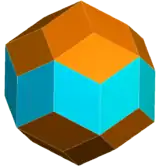Rhombic icosahedron
The rhombic icosahedron is a polyhedron shaped like an oblate sphere. Its 20 faces are congruent golden rhombi,[1] of which three, four, or five meet at each vertex. It has 5 faces (green on the first figure) meeting at each of its 2 poles (these 2 vertices lie on its axis of (5-fold) symmetry), and 10 faces following its equator (2 of their 4 edges (each) lie on the equator polyline). It has D5d, [2+,10], (2*5) symmetry, order 20.
| Rhombic icosahedron | |
|---|---|
 | |
| Type | zonohedron |
| Faces | 20 golden rhombi |
| Edges | 40 |
| Vertices | 22 |
| Faces per vertex | 3, 4 and 5 |
| Dual polyhedron | irregular-faced pentagonal gyrobicupola |
| Symmetry | D5d, [2+,10], (2*5) |
| Properties | convex, zonohedron |
Even though all its faces are congruent, the rhombic icosahedron is not face-transitive, since one may distinguish whether a particular face is near the equator or a pole by examining the types of vertices surrounding that face.
Zonohedron
The rhombic icosahedron is a zonohedron, that is dual to an irregular-faced pentagonal gyrobicupola. It has 5 sets of 8 parallel edges, described as 85 belts.
 |
The edges of the rhombic icosahedron exist in 5 parallel sets, seen in this wireframe orthogonal projection. |
The rhombic icosahedron forms the convex hull of the vertex-first projection of a 5-cube to 3 dimensions. The 32 vertices of a 5-cube map into 22 exterior vertices of the rhombic icosahedron, with the remaining 10 interior vertices forming a pentagonal antiprism. This is the same way one can obtain a Bilinski dodecahedron from a 4-cube and a rhombic triacontahedron from a 6-cube.
Related polyhedra
The rhombic icosahedron can be derived from the rhombic triacontahedron by removing 10 middle faces.
 A rhombic triacontahedron as an elongated rhombic icosahedron |
 The rhombic icosahedron shares its 5-fold symmetry orthogonal projection with the rhombic triacontahedron |
References
- Weisstein, Eric W. "Rhombic Icosahedron". mathworld.wolfram.com. Retrieved 2019-12-20.